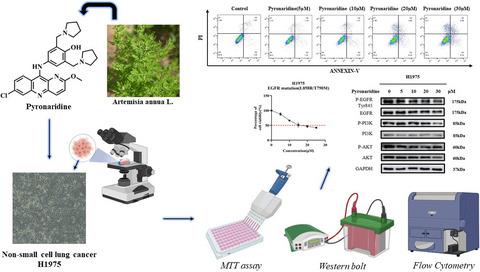当前位置:
X-MOL 学术
›
Chem. Bio. Drug Des.
›
论文详情
Our official English website, www.x-mol.net, welcomes your
feedback! (Note: you will need to create a separate account there.)
Pyronaridine induces apoptosis in non-small cell lung cancer cells by upregulating death receptor 5 expression and inhibiting epidermal growth factor receptor
Chemical Biology & Drug Design ( IF 3.2 ) Pub Date : 2021-07-21 , DOI: 10.1111/cbdd.13926 Zheng-Hong Zhong 1, 2 , Ze-Lin Yi 1 , Yi-Dan Zhao 1 , Jue Wang 1 , Ze-Bo Jiang 1 , Cong Xu 1 , Ya-Jia Xie 1 , Qi-Da He 1 , Zi-Yan Tong 1 , Xiao-Jun Yao 1 , Elaine Lai-Han Leung 1 , Paolo Saul Coghi 1 , Xing-Xing Fan 1 , Min Chen 1, 2
Chemical Biology & Drug Design ( IF 3.2 ) Pub Date : 2021-07-21 , DOI: 10.1111/cbdd.13926 Zheng-Hong Zhong 1, 2 , Ze-Lin Yi 1 , Yi-Dan Zhao 1 , Jue Wang 1 , Ze-Bo Jiang 1 , Cong Xu 1 , Ya-Jia Xie 1 , Qi-Da He 1 , Zi-Yan Tong 1 , Xiao-Jun Yao 1 , Elaine Lai-Han Leung 1 , Paolo Saul Coghi 1 , Xing-Xing Fan 1 , Min Chen 1, 2
Affiliation

|
Lung cancer is the leading cause of cancer death. Pyronaridine, a synthetic drug of artemisinin, has been used in China for over 30 years for the treatment of malaria, but its effect on non-small cell lung cancer (NSCLC) cells is rarely reported. In this study, we determined the efficacy of pyronaridine in four different NSCLC cell lines and explored its mechanism in H1975. The data showed that pyronaridine could upregulate the expression of TNF-related apoptosis-inducing ligand (TRAIL)-mediated death receptor 5 to promote cellular apoptosis. Meanwhile, the JNK (c-Jun N-terminal kinase) level was detected to be significantly increased after treating with pyronaridine. We used JNK inhibitor and found that it could partially inhibit cell apoptosis. The results showed that epidermal growth factor receptor (EGFR), PI3K, and AKT were downregulated after the treatment of pyronaridine. In summary, pyronaridine can selectively kill NSCLC by regulating TRAIL-mediated apoptosis and downregulating the protein level of EGFR. It is a promising anticancer drug for NSCLC.
更新日期:2021-07-21











































 京公网安备 11010802027423号
京公网安备 11010802027423号